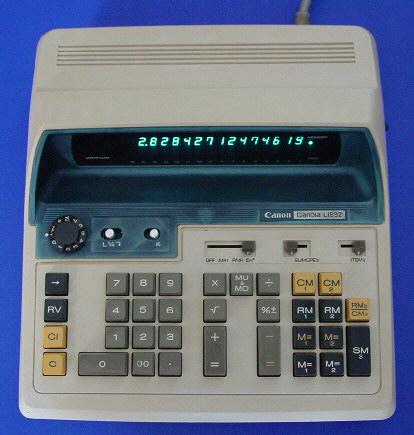
DATAMATH CALCULATOR MUSEUM
 |
DATAMATH CALCULATOR MUSEUM |
Canon Canola L1632
| Date of introduction: | 1977 | Display technology: | Fluorescent |
| New price: | Display size: | 16 | |
| Size: | 11.4" x 10.2" x 3.8" | ||
| Weight: | 4 pounds 9 ounces | Serial No: | 301561 |
| Batteries: | n.a. | Date of manufacture: | year 1977 |
| AC-Adapter: | 220V | Origin of manufacture: | Japan |
| Precision: | 16 | Integrated circuits: | TMS1370/ZA0543 |
| Memories: | 3 | ||
| Program steps: | Courtesy of: | Joerg Woerner |
 At
a first glance the Canon Canola L1632 looks very common. We know the housing
from the
Canola F-11 statistical desktop calculator introduced already in 1975.
At
a first glance the Canon Canola L1632 looks very common. We know the housing
from the
Canola F-11 statistical desktop calculator introduced already in 1975.
![]() A
first calculation (the common square-root of 8) reveals a display with 16-digits
of precision.
A
first calculation (the common square-root of 8) reveals a display with 16-digits
of precision.
 A
deeper study of the keyboard gives 3 full memories ! Now we should think about
this calculator. All known calculator architectures manufactured by Texas
Instruments control a maximum of 12 digits (Canola L121F
with TMS0201, TMS0302).
A
deeper study of the keyboard gives 3 full memories ! Now we should think about
this calculator. All known calculator architectures manufactured by Texas
Instruments control a maximum of 12 digits (Canola L121F
with TMS0201, TMS0302).
 Dismantling
the Canola L1632 is a simple but surprising job: A small single-chip
microcomputer on a huge printed circuit board (PCB) surrounded by dozens of
discrete components.
Dismantling
the Canola L1632 is a simple but surprising job: A small single-chip
microcomputer on a huge printed circuit board (PCB) surrounded by dozens of
discrete components.
![]() The
single-chip microcomputer was manufactured by Texas Instruments and gives only
two numbers:
The
single-chip microcomputer was manufactured by Texas Instruments and gives only
two numbers:
|
• ZA0543: This is the ROM-code used with TMS1000
microcomputer family • KAP7706: The four digits define the week and year of manufacturing. |
Texas Instruments released between 1974 and 1978 about 10 different TMS1000 members. With only four pieces of information we are able to trace down to the exact type:
|
• 16-digit display capacity, 40-pin housing: TMS12xx,
TMS13xx, TMS16xx • Fluorescent display: TMS127x, TMS137x, TMS167x • 3 full memories plus about 4 working registers needs more than 112*4 Bits of RAM: TMS130x, TMS160x • Manufactured in 1979: TMS1370 |
If you have additions to the above article please email: joerg@datamath.org.
© Joerg Woerner, July 22, 2002. No reprints without written permission.